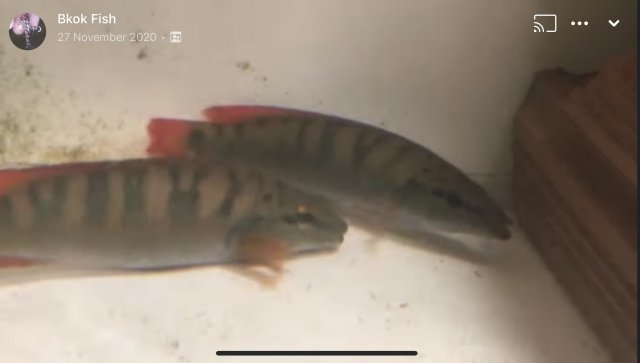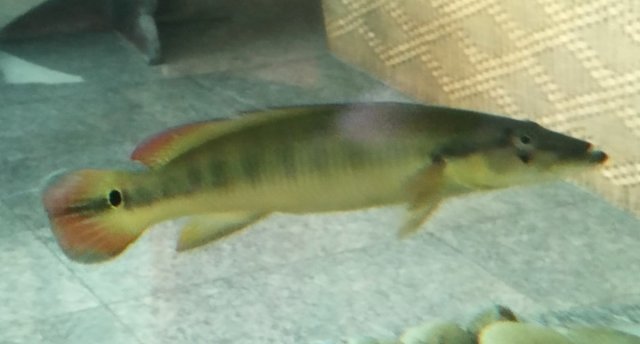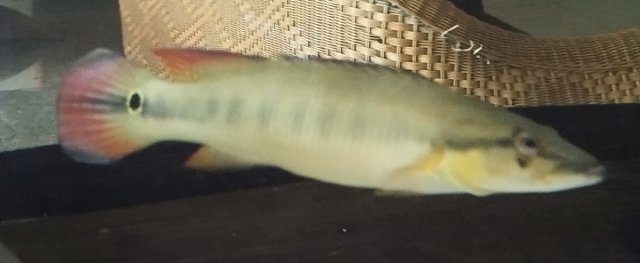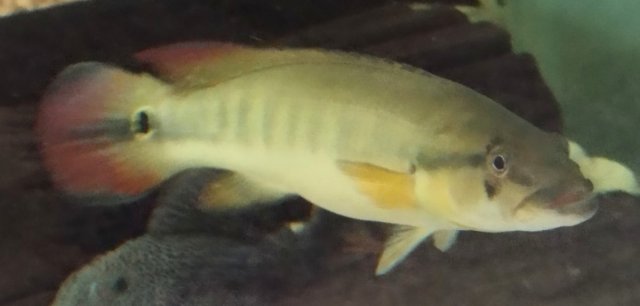Can someone ID these Pikes might pick up a couple
- Thread starter M3AN ONE
- Start date
You are using an out of date browser. It may not display this or other websites correctly.
You should upgrade or use an alternative browser.
You should upgrade or use an alternative browser.
These are an undescribed Crenicichla (lacustria) sp. I am not fully positive on size but know they do not get big. I would reckon they are almost fully grown.
The closest described species to them are C. empheres; the distinguishing factor being C. empheres have a caudal spot above the lateral line which these fish do not have.
This sp. are from the Uruguay drainage but not the country, so the most appropriate name for them is C. sp. Uruguay (as in the Uruguay drainage).
This is definitely the same species and could be larger developed ones but very hard to tell given limited information and context from the poster (they could totally be fish that happen to be colored up or look big due to the tank or video perspective):
I also believe they might be the same as the ones in this video recorded in by Cesar Schmitke, but again, not completely sure:
If you are looking to purchase them, care would be similar to any other Southern Crenicichla (lacustria) sp., such as C. minuano.
The closest described species to them are C. empheres; the distinguishing factor being C. empheres have a caudal spot above the lateral line which these fish do not have.
This sp. are from the Uruguay drainage but not the country, so the most appropriate name for them is C. sp. Uruguay (as in the Uruguay drainage).
This is definitely the same species and could be larger developed ones but very hard to tell given limited information and context from the poster (they could totally be fish that happen to be colored up or look big due to the tank or video perspective):

I also believe they might be the same as the ones in this video recorded in by Cesar Schmitke, but again, not completely sure:
If you are looking to purchase them, care would be similar to any other Southern Crenicichla (lacustria) sp., such as C. minuano.
Last edited:
I have got a Xingu 1. Although, as it has grown, it does not look like (looks better than) what I thought a Xingu 1 was going to be like. It does have a caudal spot, but it also looks a lot like what you have got.
Do I really have a Xingu 1, or is it something else?
View attachment 1545396
View attachment 1545397
View attachment 1545398
Your fish is Lugubria sp. Xingu 1. Their adult colors can vary from yellow to green and females will have a bright pink belly and white dorsal stripe. You’ll notice that the caudal spots in Xingu 1 are ocellated unlike C. sp. Uruguay in the post.
There is also difference in size, Xingu 1 are in genus Lugubria and sp. Uruguay are in genus Crenicichla (lacustria). Members of Lugubria often grow large, getting to 14” and Crenicichla (lacustria) don’t usually get over 10”, with C. sp. Uruguay probably maxing out at around 6-8”.
Additionally, there is the factor of catch location. Exporters are very familiar with L. sp. Xingu 1, they are found in the Volta Grande area of the Rio Xingu and the people who collect them know what pike cichlids are found in that area. Xingu 1 are also very distinct as young, they look like bright french fries with black stripes. Xingu 1 will usually not get misidentified in the trade, the only time I’ve seen them mixed up is with C. sp. Xingu 2, which has decently similar adult coloration to that of Xingu 1. The Xingu river is also very far from the Uruguay drainage, so, through catch location, mixups cannot really occur.
There are also other morphology differences, such as patterns and body shape that mark differences between members of Lugubria and Crenicichla (lacustria). But I’m not sure if they are worth getting into, unless you are curious of course.
In yall humble opinion is it likely that they will remain looking like the video and picture into adulthood? I only really have interest if it keeps those colors.
In yall humble opinion is it likely that they will remain looking like the video and picture into adulthood? I only really have interest if it keeps those colors.
There is genuinely not enough information to say. You would have to make an informed guess.
You can try considering these facts:
1. This fish likely does not exceed 8”, if you can find out the size of these fish, you can gauge their age. If they are 6” I would guess they would keep the red fins into adulthood
2. The photo I provided from “bkok fish”. The fish seem to be big and have green bars but we cannot know for sure given the context of the source.
3. The video I provided from Cesar Schmitke which was recorded in Misiones. If those fish are C. sp. Uruguay, they would in fact be adults as they were rearing fry. And in that video, they are greener and do not have red fins. But I am not 100% positive on the identity of those fish.
4. Crenicichla (lacustria) empheres, the closest species to this, are incredible fish but do not have the most magnificent coloration.
5. A bit unrelated but personally, I don’t think it is good to buy from Predatory Fins.
Last edited:
There is genuinely not enough information to say. You would have to make an informed guess.
You can try considering these out of curiosity why not? I always have had a good experience especially when trying to source hard to fine items
5. A bit unrelated but personally, I don’t think it is good to buy from Predatory Fins.
I have always had a good experience buying from them. Healthy hard to source fish
More of a personal reason to me, I don’t want to support bringing in endangered fish and “short bodied” fish. I’ve also seen viral melanoma on some of their pike cichlids, which should not be sold to customers.
I can expand on this further of course, but maybe via PM.






